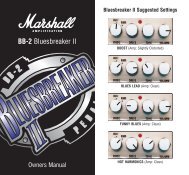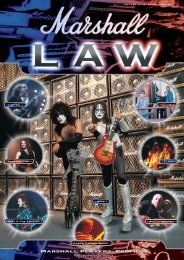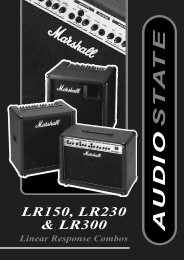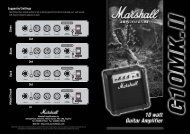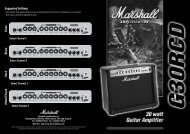AVT150X, AVT150HX & AVT275X - Marshall
AVT150X, AVT150HX & AVT275X - Marshall
AVT150X, AVT150HX & AVT275X - Marshall
Create successful ePaper yourself
Turn your PDF publications into a flip-book with our unique Google optimized e-Paper software.
ENGLISH<br />
Introduction<br />
What is AVT?<br />
Advanced Valvestate Technology, or AVT for short, is a major step forward in hybrid amplifier design<br />
which is exclusive to our Advanced Valvestate Series of amplifiers. It has evolved from the original,<br />
critically acclaimed <strong>Marshall</strong> Valvestate technology, but is improved so that it emulates even more<br />
closely the feel and response of the classic <strong>Marshall</strong> all-valve power stage...without using valves.<br />
It is not only the power stage that has been significantly improved in the series either. Much careful<br />
attention to detail and many hours of development have also gone into the preamp section too. As a<br />
result, each AVT channel offers the widest possible range of control and shape to your sound, with an<br />
ECC83 (a.k.a.12AX7) preamp valve adding to the all-important tone and feel of these latest <strong>Marshall</strong><br />
creations.<br />
Valve Drive Preamp<br />
As just stated, each amp in the range boasts a preamp stage equipped with an ECC83 Dual Triode<br />
valve. Drawing on our vast experience in this field, we have gone to great lengths to ensure that this<br />
precious device delivers maximum sonic benefit at all settings and volume levels. As a result, the<br />
clean sounds ring with the ‘bell-like’ harmonics that only a valve preamp can deliver and the break-up<br />
is never harsh or unnatural sounding. Whenever an AVT Overdrive channel is selected the ECC83’s<br />
dual triode is saturated to its limit, providing the dynamics and feel worthy of a place in the <strong>Marshall</strong><br />
hall of fame.<br />
Power Amp Delivery<br />
The same sort of toneful care and attention was also focused on the all-important power stages of the<br />
AVT series too. Our goal was to ensure that each one would create the warm, musical feel and 3dimensional<br />
sounds that have made our all-valve power amps world renowned. In addition, these AVT<br />
products were designed to deliver the goods in the often hostile and unpredictable environment of the<br />
live performance stage - which is why all the AVT power amps, from the AVT50X upwards, are fan<br />
cooled for optimum reliability.<br />
'Extended Bass Response' Loudspeakers<br />
Knowing how important the relationship between the amplifier and speaker is, this is another area<br />
where we spent a great deal of time and effort when developing the AVT Series. By working extremely<br />
closely with our long-term colleagues at Celestion Loudspeakers, we have successfully developed a<br />
range of speakers which, through radical design, re-define the state-of-the-art in rock guitar<br />
reproduction. In a nutshell, they allow the compact closed back cabinets used in the AVT range, to<br />
maintain the bottom end delivery normally only associated with a full 4 x12 cabinet set-up.<br />
DFX Onboard<br />
At <strong>Marshall</strong> our aim is to create products that offer our fellow guitarists true inspiration in the practice<br />
and performance of their art. When integrating DFX (Digital Effects) into the tonal topology of AVT, the<br />
greatest care was taken to ensure that the highest level of signal integrity was maintained. Through<br />
careful shaping and mixing of the ‘wet’ (processed) and ‘dry’ (unprocessed) signals, we have ensured<br />
that the onboard effects enhance your tone while adding none of the nasty, artificial ‘grain’ often<br />
associated with DFX. Different effect types can be assigned to the Clean and Overdrive channels and<br />
can, of course, be turned on and off via the sturdy 6-way LED foot controller supplied with your amp.<br />
<strong>AVT150X</strong> & <strong>AVT150HX</strong> Front Panel Features<br />
I. The Preamp Section<br />
Your AVT amp boasts no fewer than four<br />
channels: Acoustic Simulator, Clean, Overdrive<br />
1 and Overdrive 2. The preamp section is where<br />
the gain, tone and relative volume of these four<br />
channels is determined.<br />
1. Input Jack Socket<br />
This is where you plug your guitar into the amp.<br />
You must always use a screened (shielded)<br />
guitar cable and never use an unscreened<br />
(unshielded) speaker cable. Also, this cable<br />
should be one of good quality. If you are in any<br />
doubt regarding this, your <strong>Marshall</strong> dealer will be<br />
more than happy to help and advise you.<br />
2. Acoustic Sim. Channel Selector Switch<br />
Allows selection of the Acoustic Simulator<br />
channel via the front panel.<br />
3. Top Control<br />
This control takes the channel’s sound from a<br />
mellow, acoustic tone (similar to a microphone<br />
placed towards the neck of the instrument) all<br />
the way to a bright, piezo-like acoustic sound<br />
and all points in-between.<br />
Note: The amp’s Master Presence control (21)<br />
affords you further adjustment of the high end.<br />
4. Body Switch<br />
This changes the ‘body resonance’ simulation of<br />
the channel from that of a regular sized, steelstring<br />
acoustic (switch ‘out’) to that of a large<br />
bodied, ‘Jumbo’ acoustic (switch ‘in’).<br />
5. Volume Control<br />
This dictates how loud the Acoustic Simulator<br />
Channel will be.<br />
8. Bright Switch<br />
Most of the Gain controls in classic <strong>Marshall</strong><br />
amps have been fitted with what is known as a<br />
‘treble bleed capacitor’. This device allows extra<br />
high frequencies to be ‘bled’ through to the drive<br />
section when the Gain control is at low settings.<br />
Engaging the Bright Switch will ‘bleed’ extra high<br />
frequencies into the drive stage of the Clean<br />
channel, giving you a bright, clean tone perfect<br />
for many styles, including funk and country.<br />
The higher the Gain control is set, the less effect<br />
the ‘treble bleed capacitor’ has. As a result, at<br />
maximum Gain settings, the bright switch will<br />
have no audible effect at all.<br />
9. Clean Volume Control<br />
As its name suggests, this control determines<br />
the volume of the clean channel. The actual<br />
setting you choose will be dependent on how<br />
loud you want the channel to be, and also on<br />
the type of sound you have selected on the preamp.<br />
Due to the remarkable realism of our<br />
Advanced Valvestate Technology, once the<br />
Volume control is turned-up past a certain point<br />
the preamp will start to push the power amp<br />
section into creating its own, desirable distortion<br />
- just like an all-valve <strong>Marshall</strong> amp. When this<br />
occurs, the AVT’s power amp will start to add<br />
musical harmonics, compression and ‘break-up’<br />
into your sound.<br />
Note: As each channel has its own volume<br />
control, you can easily balance the levels of all<br />
four channels as you so desire. Once set to your<br />
satisfaction, these controls can be left alone and<br />
you can use the amp’s Master Volume knob (20)<br />
to set your overall volume level.<br />
6. Clean Channel Selector Switch<br />
10. Clean Tone Controls<br />
The Clean channel is equipped with rotary Bass,<br />
Middle, and Treble controls. These three passive<br />
This allows selection of the Clean channel via EQ controls are designed to achieve maximum<br />
the front panel.<br />
tonal variation from your AVT amplifier and, just<br />
like the tone controls on our famous all-valve<br />
7. Clean Channel Gain Control<br />
amps, are highly inter-dependent on each other.<br />
This rotary control regulates the drive into the As a result, the way each one functions depends<br />
two cascaded valve stages of the preamp. on the exact position of the other two controls.<br />
Lower settings will give you a wide range of well This is especially true of the Bass and Treble<br />
defined, warm clean tones.<br />
controls in relation to the Middle control. As you<br />
will discover, the lower the Middle control is set,<br />
At higher Gain settings you will pass through<br />
natural, valve-induced compression and into an<br />
the more ‘reactive’ the others become.<br />
increased level of desirable ‘break-up’ (a.k.a. As tone is very much down to personal taste,<br />
‘crunch’) which is perfect for subtly overdriven experimentation and experience is probably the<br />
2<br />
blues/rock.<br />
3<br />
best way of learning how these three controls<br />
ENGLISH






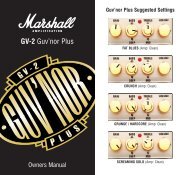

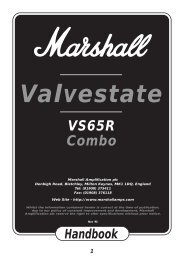
![AVT100X [2.16 MB] - Marshall](https://img.yumpu.com/11365367/1/184x260/avt100x-216-mb-marshall.jpg?quality=85)

